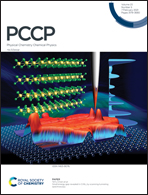Electron leakage through heterogeneous LiF on lithium–metal battery anodes†
Abstract
The solid–electrolyte interphase (SEI) that forms on lithium ion battery (LIB) anodes prevents degradation-causing transfer of electrons to the electrolyte. Grain boundaries (GBs) between different SEI components, like LiF, have been suggested to accelerate Li+ transport. However, using the non-equilibrium Green's function technique with density functional theory (NEGF-DFT), we find that GBs enhance electron tunneling in thin LiF films by 1–2 orders of magnitude, depending on the bias. Extrapolating to thicker films using the Wentzel–Kramers–Brillouin (WKB) method emphasizes that safer batteries require passivation of GBs in the SEI.



 Please wait while we load your content...
Please wait while we load your content...